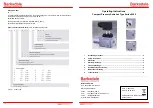
181
priority, or highest Router ID in case of a tie (chapter 2,3 “
Configuring OSPF
”).
Area Border Router
– An Area Border Router (ABR) must be configured between each
area and the backbone. An ABR should be configured with an IP interface that connects
directly to both the backbone and the area on which it borders (chapter 2,3 “
Adding an
IP Interface
”). However, if an area is not physically connected to the backbone, you can
configure a virtual link that crosses a neighboring area to reach the backbone. Just
define an ABR (i.e., virtual neighbor) on the boundary between the isolated area and
transit area, as well as an ABR on the boundary between the transit area and the
backbone. An ABR can be situated between one or more areas, but we advise limiting
the maximum number of areas supported by a single ABR to three. You can also define
a virtual link as a backup path between an ABR and the backbone.
Area Range
– An ABR maintains a separate routing table for each area to which it is
attached, and sends routing summaries for each attached area to the backbone, which
in turn distributes this information to other areas in the autonomous system. This
reduces the size of the routing tables that have to maintained throughout the system,
and prevents frequent updates from flooding the system whenever a link change occurs.
To configure a routing summary, you must define the OSPF Area Range for all the
networks within an ABR’s area. This range is specified with an IP address and network
mask (chapter 2 “
OSPF Area Configuration
” or chapter 3 “
OSPF Area Range
Configuration
”). Moreover, since OSPF supports Variable Length Subnet Masks
(VLSMs), you can specify a mask on a bit boundary, which can further reduce the
number of advertised addresses.
Autonomous System Boundary Router
– An Autonomous System (AS) contains all the
routers in your network, each of which shares information with other routers to
determine a shortest-path route to every destination in the AS. However, when an AS is
connected to an outside network, it must import external routing information through an
Autonomous System Boundary Router (ASBR). An ASBR can import routing information
through other routing protocols such as RIP.
An ASBR will generate external link advertisements on selected interfaces if OSPF is
enabled globally (chapter 2 “Protocol Configuration”), and any of the following
conditions exist on an interface:
• RIP is enabled (chapter 2 “
Adding an IP Interface
” or chapter 3 “
Adding an IP
Interface
”), or
• RIP and OSPF are both disabled (chapter 2 “
Adding an IP Interface
” or chapter 3
“
Adding an IP Interface
”).
Link State Advertisements
– Each router maintains a link state database that contains
information received from all the other routers within the same area (chapter 2
“
Displaying the Interface Table
” or chapter 3 “
Displaying the Interface Table
”). There are
















































